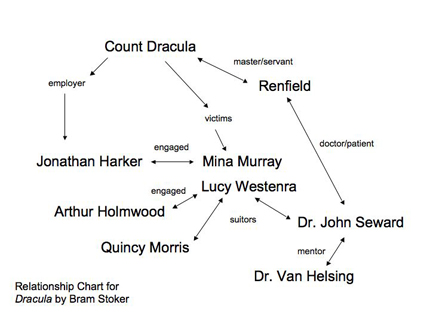Reading a Novel or Story

Welcome to the Purdue OWL
This page is brought to you by the OWL at Purdue University. When printing this page, you must include the entire legal notice.
Copyright ©1995-2018 by The Writing Lab & The OWL at Purdue and Purdue University. All rights reserved. This material may not be published, reproduced, broadcast, rewritten, or redistributed without permission. Use of this site constitutes acceptance of our terms and conditions of fair use.
This resource discusses pointers for reading and responding to a novel or story.
Other OWL Resources:
Reverse Outlining: An Exercise for Taking Notes and Revising Your Work
Pay Attention to Relationships
Whether bonds of blood or emotion that tie characters together, it is their connections to each other and the way those connections evolve that forms the central action of much fiction. Consider drawing a brief relationship chart like this:

Relationship Chart for Bram Stoker's Dracula
Listen to Characters
When characters in novels speak or ponder at length, it’s time to pay attention. Like soliloquies in drama, a lengthy speech or inner monologue can give you insight into the character’s motives, an idea of his or her world view, and even a clue to central themes in the work.
Practice: Go back over a chapter or story you just read, looking at only what is written inside quotation marks. If the book you’re reading is yours, highlight or otherwise mark each one. Now, read through the chapter once more, reading only your marked passages.
Look Out for Re-occurring Images, Phrases, or Bit Characters
Poetry isn’t the only place to find verbal imagery and symbolism. If you find yourself asking “Haven’t I seen this before?” then you may have discovered an important motif.
Practice: After you’ve finished a novel, re-read the first chapter and see if you recognize any key words from the last chapter of the book. Are there any similarities or coincidences between the two?